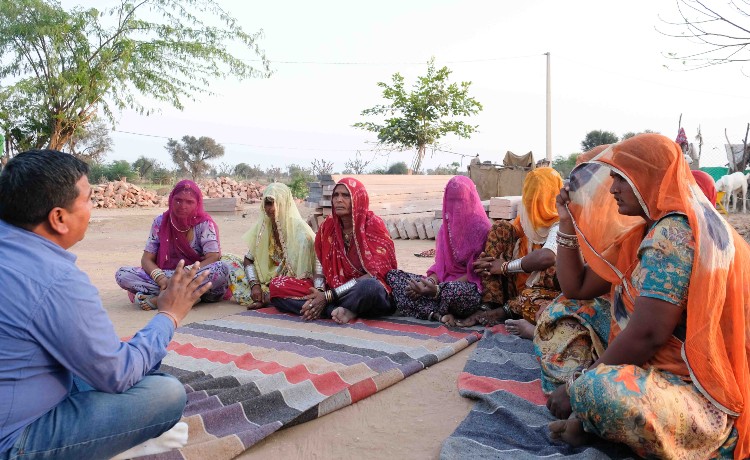Over
the last few years, much introspection was done on the issue of ‘Gender’ and Ambuja Foundation’s approach to it – at both a community and organisational level.
Women empowerment has always been a core area for Ambuja Foundation. Till
date, the need of the hour has been to take a ‘Women & Development’
approach – working directly and primarily with women and enabling them to gain
access to information, opportunities and resources that till now, have eluded
them.
However, with so much progress made in this area over the past 3 decades, there was a felt need to take programs to the next level and finding ways to bring systemic changes for gender equality, rather than merely trying to enable women within the existing, gender imbalanced system.
This transition is part of a natural ‘evolution’ - it is often only the very small ‘feminist’ NGOs, or the very large international NGOs, who really look to make systemic change when it comes to gender norms within societies. However, having achieved radical change for rural women in the communities it represents, Ambuja Foundation has reached a point where it was time to take its work on ‘gender’ to the next level.
So
what exactly is being done and how is it different from the work done till
date?
1. Adopting a ‘Gender &
Development’ Approach
Whilst
a vast amount of work is being done in India by NGOs to empower women and
provide access to a range of resources and opportunities to uplift them, the
time has come for NGOs to view their work through a ‘Gender Lens’ - going one
step further in tackling the gender inequity that is so fiercely, holding India
back.
Sadly,
we live in a world where both men and women have conditioned beliefs about the
roles different genders are supposed to play in families, communities and
society. Yes, both men and women have been socially conditioned – by
mainstream media, by cultural practices, by family systems - to believe certain
roles are meant for certain genders. These beliefs are deeply entrenched in a
country like India.
The ‘Gender & Development’ approach seeks to work with all genders and socio-economic groups in a community to tackle the gender power relations that exist there. By adopting a Gender Lens, NGOs can begin to transition from taking a Women in Development approach – which focuses purely on working with women - to one that is more oriented around Gender and Development – focusing more on the way in which gender is perceived, and the roles/responsibilities that are assigned, by everyone in a community. Men. Women. And transgender.

2. Appointment of a ‘Lead on
Gender Integration’ to Facilitate the ‘Shift’
A few
years back, Ambuja Foundation had started drafting initiatives to sensitize gender in
development and integration. The organization realized that it needed
a professional to drive this force and thus in 2022, hired an experienced
senior level resource person to lead this program within the organisation with a focused attention to steer the shift in thinking at all levels from ‘women empowerment’ to ‘gender
integration.’
“Initially
our focus was to ensure that the entire Ambuja Foundation team of 1500 people were trained to
understand the Gender Lens and its impact and integration points on their own
programmes. We did an intensive 3 day program for team members on this,
covering topics of Sex & Gender, Construct of Gender, Patriarchal Systems,
Access & Control, Equity among others.” Medhavinee Namjoshi, Lead – Gender
Integration, Ambuja Foundation
“We then started to review our own interventions to see where our programs fit
on the gender spectrum – were they gender blind, gender aware, gender
sensitive, gender responsive or gender transformative? And what needed to be
done to move the needle towards more gender transformative programs. We found
that a lot of our programs were at a level of being gender responsive or gender
sensitive but had great potential to be gender transformative. This was
exciting to discover and did a lot to motivate the team.” She said.
3. Reviewing Programs Through
a ‘Gender Lens’
Just
as we rely on a pair of glasses to help us see more clearly, there is a need
for NGOs to put on a pair of glasses loaded with ‘Gender Lenses’ to review the
activities in which they are undertaking, the way in which they are
communicating and the outcomes they are expecting in their work.
In doing so, NGOs can start to see where their work falls on the ‘gender spectrum’, and put in place initiatives to move things from being ‘gender unequal or gender blind’ to being ‘gender responsive or gender transformative.’

It is
important for this lens to not only be applied by management, but for field
workers and beneficiaries to also begin to recognise the pre-conditioned views
they have around gender.
In
Chandrapur, Maharashtra, a group of cotton farmers and Ambuja Foundation field workers were
introduced to the gender lens and spectrum to assess where things sat in
relation to their work around growing Better Cotton. One
field worker jumped up with a bold realisation – “I now realise our paintings
and communications are gender blind – whenever we put up wall paintings in
villages, we always paint a man!” Very gender blind, when, according to
the International Trade Centre, women cotton farmers account for 70% of the
labour in sowing and 90% of the labour in cotton picking in India. Given the
criticality of the production-related tasks that women perform, women farmers
directly impact the quantity and quality of cotton produced – and should
therefore be represented in wall paintings.
4. Review ACF Organisation
& Office in Relation to ‘Gender’
Also
under the lens, is Ambuja Foundation’s internal structure and human resource practices.
As an equal opportunity organisation, Ambuja Foundation has for a number of years been
trategic and conscious in hiring women across verticals, locations and
positions, and this continues, including finding ways to support women and
empower their growth within the organisation.
Additionally,
there are a number of initiatives for creating an enabling environment for
women employees - establishing platforms like Pankh, which is a platform providing
the right atmosphere for women. All importantly, we take the POSH act very
seriously in educating both men and women on the expected behaviours at the
workplace and its consequences.
5. Prioritising a Platform for
Women via the ‘Pankh’ Forum
Ambuja
Cement Foundation also continues to prioritise ‘PANKH’ - a women’s forum where
women at Ambuja Foundation can voice their opinions, learn and share experiences. This forum
is especially designed for and by women members part of Ambuja Foundation's staff team.
The
forum was built to unleash innovative ideas and thoughts amongst Ambuja Foundation's team members to create an opportunity of domains they haven't tried like hosting the forum. The forum also helped in focusing on topics with prioritize the needs of the women. The platform opens avenues to ponder upon like
professionalism, work ethics and ethos with women at ACF trained as
leaders, an opportunity emerged to harness their growth and use these qualities
at the grassroots.
With
over 468 women contributing to the employee strength at Ambuja Foundation, almost half of
whom have also been with the organization for the last 10-20 years, there
is wealth of knowledge to leverage and share. With a strong
understanding of the nuances of Ambuja Foundation, and vast experience in the development
sector there is great scope for these women employees to become mentors to
the younger generation - helping them find a balance and place in the
industry.
“Every woman at Ambuja Foundation comes from a different background, and getting together on one common platform offers a participatory approach allowing them to be part of the interaction and debates during the forum. I look forward to actively being a part of this forum and hearing the personal experiences, viewpoints and guidance our strong women have to offer,” says Pearl Tiwari, Director & CEO, Ambuja Foundation.
Conclusion
This type of work requires a lot of patience. “There is a need for all stakeholders to understand that it takes time to see the fruits of this approach. For systemic, grassroots change, it needs long term interventions and strategies. In this way, what we are doing today, will show results 5 -10 years down the line. There is also a lot of nuance in understanding the differences of each location – we cannot have the same intervention across all locations because a village in Maharashtra is very very different from a village in Himachal Pradesh. Even within communities, socio economic groups are also very different.” Medhavinee Namjoshi says.
“It will take time to understand and start implementing, but it’s important to get started on the journey.” Pearl Tiwari said.
*https://inee.org/collections/gender







0 Comment